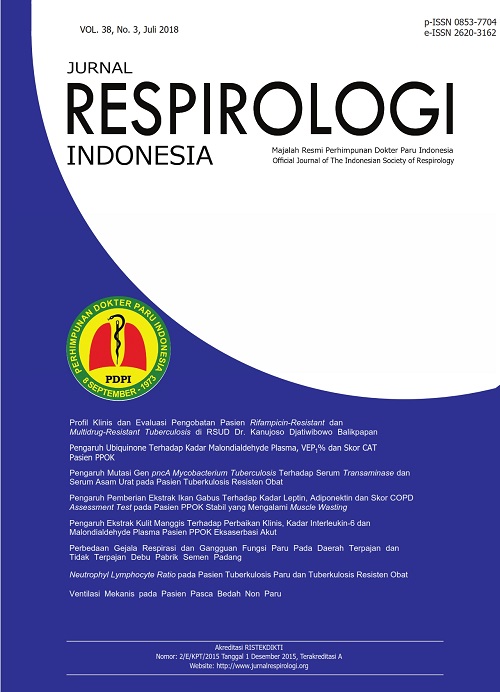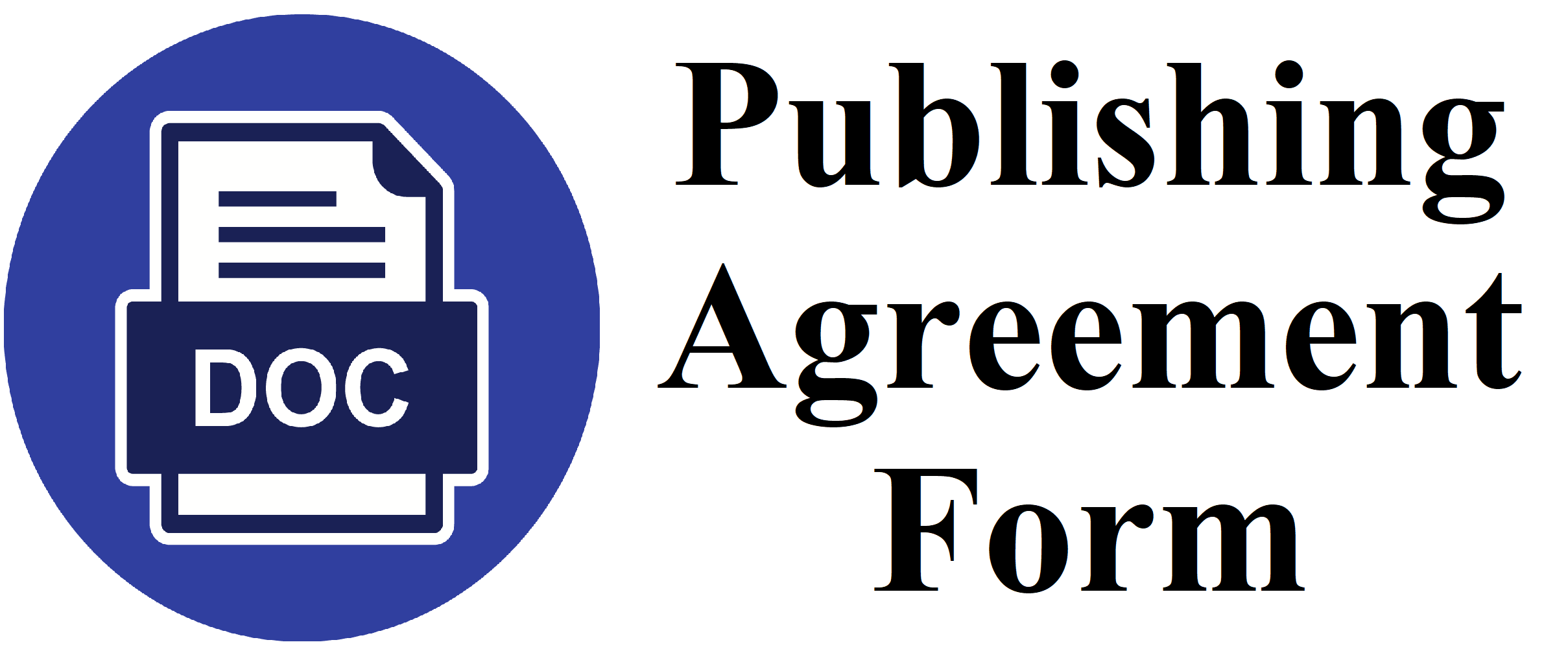Effect on Ubiquinone MDA Level of Plasma, FEV1% and CAT Score Stable COPD Patients
DOI:
https://doi.org/10.36497/jri.v38i3.3Keywords:
Ubiquinone, stable COPD, plasma MDA, FEV1%, CAT scoresAbstract
Background: Oxidation stress showed clinical evidence of increased in patients with COPD and contribute functionally to expiratory air flow resistance, so the body requires exogenous antioxidants to inhibit oxidative stress. This study was conducted to assess whether there is influence on levels of MDA plasma ubiquinone, FEV1% and patients with stable COPD CAT score. Methods: This study is a clinical trial experimental with pretest and post-test design which aims to determine the effect of plasma MDA, FEV1% and patients with stable COPD CAT score. Subjects consist of 30 patients with stable COPD who came to Pulmonary outpatient clinic of Moewardi hospital Surakarta during June to August 2016. The sample was taken by consecutive sampling. Subjects were divided into two group, the treatment group (n=15) received additional therapy ubiquinone 1x150mg/day and the control group (n=15) received standard therapy. MDA plasma levels, FEV1% and CAT scores were measured at the time of control pulmonary outpatient clinic. Results: Giving ubiquinone can significantly lower CAT score better in the treatment group compared to the control group. There were no statistically significant difference (p=0.744) in plasma MDA treatment group (1.37 ± 0.11) compared to controls (1,39 ± 0.16). There were no statistically significant difference between (p=0.276) the decline in FEV1% treatment group (43.28 ± 20.59) and the control group (36.01 ± 14.73). Conclusion : The use of Ubiquinone in decreasing CAT score for stable COPD patients. There was lowering effect in MDA plasma but there was no excalation value in FEV1%.Downloads
References
Senior RM, Atkinson. Chronic obstructive pulmonary disease: epidemiology, pathophysiologi, and pathogenesis. In: Fishman AP, Elia JA, Fishman JA, Grippi MA, Senior RM, Pack AI, editors. Fishman’s pulmonary disease and disorder. 4th edition. New York: McGraw Hill Medical; 2008.p.708-27.
Cavalcante AG, Brain PF. The role of oxidative stress in copd: current concepts and perspectives. J Bras Pneumol. 2009;35:1227-37.
Global initiative for chronic obstructive lung disease. Global strategy for the diagnosis, management, and prevention of chronic obstructive pulmonary disease update 2015. [Online]. 2015 [Cited 2016 January 5]. Available from:http://www.goldcopd.org/uploads/users/files/GOLD_Report_2015.pdf.
Roca M, Verduri A, Corbetta L, Clini B, Fabbri LM, Beghe B. Review article mechanism of acute exacerbations of respiratory symptoms in chronic obstructive pulmonary disease. Eur J Clin Invest. 2013;4:510-21.
Antuz B, Harnasi G, Drozdovszky O, Barta I. Monitoring oxidative stress during chronic obstructive pulmonary disease exacerbations using malondialdehyde. Respirology. 2013;19:74-9.
Barnes PJ. New anti-inflammatory targets for chronic obstructive pulmonary disease. Nature Reviews. 2013;12:543-59.
Desai U, Gothi D, Joshi JM. COPD exacerbation: clinical management options. India Journal of Clinical Medicine. 2012;3:1-15.
Curtis JL, Freeman CM, Hogg JC. The immunopathogenesis of chronic obstructive pulmonary disease. Am Thorac Soc. 2007;4:512-21.
Pragati K, Kapoor Ak. Coenzyme Q10- a novel molecule. Indian Academy of Clinical Medicine Journal. 2013;14:37-45.
Nantes IL, Rodriques T, Cesar H, Yokomizo, Juliana C, Araujo C. Antioxidant action of mobile electrone carriers of the respiratory chain. [Online]. 2016 [Cited 2016 Januari 30]. Available from: http://www.intechopen.com/books/bioenergetics/antioxidant-action-of-mobile-electron-carriersof-the-respiratory-chain.
Weston SB, Zhou S, Weatherby RP, Rubson SJ. Does exogenous coenzyme Q10 after aerobic capacity in endurance athlets. Int J Sport Nutr. 1997;7:197-206.
Malm C, Svensson M, Ekblom B, Sjodin B. Effects of ubiquinone-10 supplementation and high intensity training on physical performance in human. Acta Physiological Scandinavia. 1997;161:379-84.
Cooke M, Losia M, Buforfd T, Shelmadine B, Hudson G, Kerksick C, Rasmussen C, Greenwood M, Leutholtz B, Willoughby D, Kreider R. Effects of acute and 14-day coenzyme Q10 supplementation on exercise performance in both trained and untrained individuals. J Int Soc Sports Nut. 2008;4:5-8.
Sunnetcioglu A, Alp HH, Srtogullarindan B, Balaharoglu R,Gunbatar H. Valuation of oxidative damage and antioxiant mechanism in COPD, lung cancer, and obstructive sleep apnea syndrome. Respir Care Journal. 2015;61:205-11.
Rahman I. Antioxidant therapies in COPD. International Journal of COPD. 2006;1:15-29.
Waseem S, Hussain M, Ahmad Z, Islam N. A study of pulmonary functions and lipid peroxidation biomarker in COPD correlation between malondialdehyde and lung functions. Biomedical Research. 2012;23:66-71.
Singh Z, Karthigesu IP, Singh P, Kaur R. Use of malondialdehyde as a biomarker for assessing oxidative stress in different disease pathologies: a review. Iranian J Publ Health. 2014;43:7-16.
Downloads
Published
Issue
Section
License
- The authors own the copyright of published articles. Nevertheless, Jurnal Respirologi Indonesia has the first-to-publish license for the publication material.
- Jurnal Respirologi Indonesia has the right to archive, change the format and republish published articles by presenting the authors’ names.
- Articles are published electronically for open access and online for educational, research, and archiving purposes. Jurnal Respirologi Indonesia is not responsible for any copyright issues that might emerge from using any article except for the previous three purposes.
















